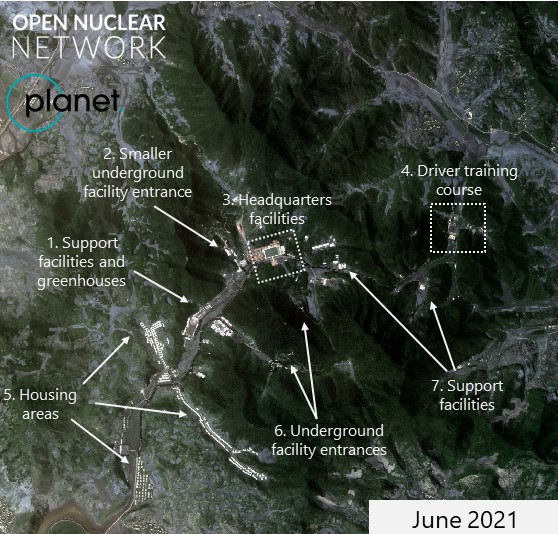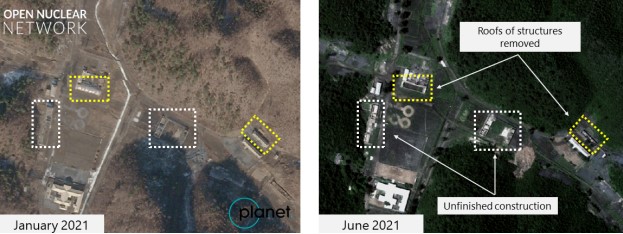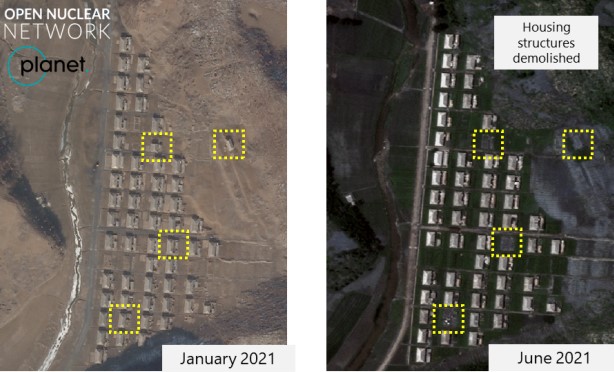The views expressed in this post are those of the author and not necessarily those of Open Nuclear Network or any other agency, institution or partner.
Summary
The Yusang-ni Missile Base [1] is one of the largest and most recently completed North Korean missile bases and reportedly hosts a number of ballistic missile systems. Recent imagery from June 2021 indicates that some relatively minor construction continues at the facility, with a number of old buildings being torn down and new buildings being added.
While the implications of these new construction activities are not immediately apparent, they demonstrate continued development and maintenance of the base. The removal of roofs from five greenhouses roughly half a kilometer west of the base’s headquarters is most immediately noticeable, while alterations to various support structures surrounding the base’s driver training course continue.
Overview of Yusang-ni Missile Base
Yusang-ni Missile Base, which has been variously reported to host Hwasong-13, Hwasong-14 and Hwasong-15 ICBM's, is located roughly 60 kilometers northeast of Pyongyang. [2] The base mainly comprises two suspected underground facilities, a hardened drive-through structure, a driver training course, a headquarters area and a large number of housing and support structures. [3]

According to the United Nations Panel of Experts, site-evolution and upgrading have been continuously observed at this location since 2014 when excavation of the tunnel (which is usable by heavy TELs) began. [4] In recent years, analyses have documented continued construction at the facility between 2019 and early 2021 [5] with, for example, the driver training course having likely been added in August or September 2019. Other minor construction activities have continued, including the razing and construction of various support and housing facilities.
New Construction Activities
Planet Labs high resolution satellite imagery from June 2021 shows that minor construction activities have continued, with a number of visible developments taking place in the base’s headquarters area, housing and support areas and near the driver training course. In the "support facilities and greenhouses" area (marked as location 1 above), the roofs of five greenhouses have been removed. Meanwhile, two other adjacent buildings appear to be in the process of being demolished.

Moving to the support facilities directly to the east of the headquarters area, there are three relatively small structures the roofs of which have been removed. In addition, we can see that another structure has been added that is slightly smaller than the structures whose roofs have been removed.

Continuing to the east, the roofs of two additional structures have been removed, one of which is directly adjacent to the course and another which is about a quarter of a mile to the east. We can also observe that two additional structures that appear to be only partially built remain in an unfinished state.

Moving towards the housing areas to the southwest of the headquarters, there has been a similar pattern of partially or completely demolishing buildings. Near the northernmost housing areas, roofs from two small structures have been removed in the support building area nearest the greenhouses.

Finally, in the southernmost housing area, a total of four housing structures have been demolished between January and June of this year.

At the time of this writing, the implications of these new construction activities are not immediately apparent. Nevertheless, the activities demonstrate ongoing development and maintenance of the base.
ONN will continue to monitor the developments on the site.
[1] Aka. "Milchon-ri" (39°27'01"N 126°15'35"E)
[2] The United Nations, S/2021/211, Paragraph 24 and Annex 16, available at: https://www.securitycouncilreport.org/atf/cf/%7B65BFCF9B-6D27-4E9C-8CD3-CF6E4FF96FF9%7D/s_20 21_211.pdf; and Joseph Bermudez and Victor Cha, Undeclared North Korea: The Yusang-ni Missile Operating Base, Center for Strategic and International Studies, 9 May 2019, available at: https://beyondparallel.csis.org/undeclared-north-korea-the-yusang-ni-missile-operating-base/
[3] Ibid.
[4] The United Nations, S/2021/211, Annex 16
[5] The United Nations, S/2021/211, Paragraph 24 and Annex 16; and Joseph Bermudez and Victor Cha, Undeclared North Korea: The Yusang-ni Missile Operating Base (Updated since 2019), Center for Strategic and International Studies, 18 February 2021, available at: https://beyondparallel.csis.org/undeclared-north-korea-the-yusang-ni-missile-operating-base-update-since -2019/
